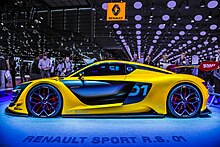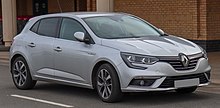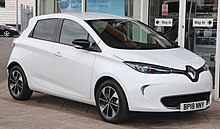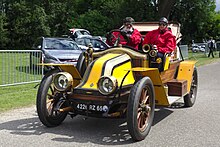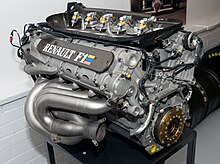Renault
Renault (French pronunciation: /rə'no/) is a French manufacturer of automobiles, commercial and racing vehicles. It is the brand derived from the founding of Groupe Renault, a conglomerate of automotive companies that also includes the Alpine (100%), Dacia (99.43%) and Samsung (80.1%) brands in its shareholding package., while being a majority member of the world alliance Renault-Nissan-Mitsubishi (44%)
From 1979 to 1987, Renault owned most of American Motors Corporation (AMC) and Jeep, which was later sold to Chrysler Corporation in March 1987. In 1986, the French government considered privatization and in 1996 Renault was already partially privatized. In January 2001, the manufacturer sold its industrial division Renault Véhicules Industriels to AB Volvo, not Volvo Cars, which it renamed Renault Trucks in 2002, becoming its majority shareholder, until the sale of its share package in 2010.
He has been honored with numerous awards for his vehicles: once the United States Motor Trend Car of the Year, six times European Car of the Year, nine times Spanish Car of the Year, three times Autobest Car of the Year in Russia, Poland, Turkey or twice Car of the Year in Ireland and Denmark.
It has competed countless times as a constructor in Formula 1 from 1977 to 1985, when it developed and introduced turbocharged engines to Formula 1, and again from 2002 to the present. During the years that Renault did not compete as a constructor, it has dedicated itself to supplying engines to various teams, achieving notable successes with Benetton and Williams F1, achieving the title as a supplier between 1992 and 1997. In 2005 and 2006 it won the constructors' world championship.
History
Foundation and early years (1898-1918)
The Renault Corporation was founded on December 24, 1898 as Société Renault Frères (Renault Brothers Society) by Louis Renault and his brothers Marcel and Fernand. Louis was a young engineer and brilliant who had already designed and built several prototypes before joining his brothers, who had honed their skills working for their father's textile company. While Louis handled design and production, while Marcel and Fernand ran the business.
The first car was the Renault Voiturette 1CV, sold to a friend of Louis's father after giving it a test drive on December 24, 1898.
In 1903, Renault began manufacturing its own engines. Until then, he had bought them from De Dion-Bouton. The first large-volume sale occurred in 1905, when Société des Automobiles de Place bought Renault AG1 automobiles to establish a fleet of taxis. These vehicles were later used by the French military to transport troops during World War I, earning them the nickname "Taxi de la Marne". By 1907, a significant percentage of London and Paris taxis had been built. by Renault.
The manufacturer was also the best-selling foreign brand in New York between 1907 and 1908.
In 1908, the company produced 3,575 units, making it the largest automobile manufacturer in the country.
By countries
Argentina
In Argentina, the brand arrived at the beginning of the 20th century, through a private importer located in the city of Buenos Aires. Models like the Juvaquatre and others, were sold in a first stage.
After the Second World War, imported units of the Renault Dauphine arrived, until in 1960 and after signing an agreement with Industrias Kaiser Argentina, it began to manufacture the Dauphine and later the Gordini, as an evolution of the Dauphine. By the end of 1963 and controlling a large part of the share package of Industrias Kaiser Argentina, the 4, 6, 12 arrived and in the 1980s, the 18, the Fuego and the Renault 11, 21 and 9.
After the change in the share package, the local subsidiary was bought by the businessman Manuel Antelo and renamed CIADEA S.A., the Renault 19 and Clio were imported first, nationalizing production in 1993 and 1996, respectively.
In 1996, the production of the Mégane was nationalized and regional production was delegated to the Nordex Uruguay plant, the manufacturing of the Express and Twingo.
In 1999 the production of the Kangoo was nationalized (replacing the Express) and by 2000, the Clio II was nationalized.
In 2008, production of the Renault Symbol began and in October 2010, production of the Fluence began.
At the beginning of 2017, the production of the Dacia Sandero II and Logan II began, under the Renault emblem. By July 2020, the production of the Alaskan began and by the end of it, the replacement of the Kangoo, using the Dacia Dokker platform.
Spain
In Spain, the brand has always been widely accepted, partly due to the factories located in the territory, these being the two in Valladolid, the one in Villamuriel de Cerrato and the one in Seville. Renault arrived in Spain in 1953 with its factory in Valladolid. Cars such as the Renault Megane, the Renault Modus, the Clio, the Renault Twizy or the Renault Captur have been produced. In turn, the factories produce parts for others, as is the case of Seville and its gearboxes. In addition, the Valladolid engine factory supplies half of the engines of the entire Renault Group in the world.
Columbia
In Colombia, the situation, already at the end of the 1980s and at the beginning of the 90s, shows a reduction, at the hands of the strong presence of GM Colmotores (Chevrolet) and already in the 90s in politics of the economic opening of the government of President Cesar Gaviria Trujillo, who does nothing more than create a new opportunity for local car manufacturers: The export of their products to countries other than the Andean Market. This is how you get to know models that would not enjoy the same fortune as those previously mentioned, such as the Renault Laguna and the Renault Scénic, but other cars such as the Renault Twingo, discontinued in July 2012 and the Renault 19, discontinued in 2005., they would manage to re-establish their lost presence in the market.
Cars such as the Dacia Logan, the Dacia Sandero and the Sandero Stepway, as well as the Dacia Duster, together with its imported cars from Turkey, Spain, Argentina and Brazil have made the brand a constant protagonist of the automotive industry.
Mexico
The brand returned to Mexico in 2001, and taking advantage of its association with Nissan, it manufactured its first generation Clio II and Scenic models.
The exchange rate in euros, the 2008 crisis and a drop in sales caused it to stop importing European models and opted to adapt Dacia/Samsung models from Brazil, Colombia and South Korea.
Currently, the manufacturer is positioned as the tenth best-selling brand in the country.
Despite the financial crisis in Latin countries, there are still some strong markets for Renault.
| Countries | Rank | Sales in 2013 |
|---|---|---|
| Brazil | 2 | 236,360 |
| Argentina | 6 | 141.217 |
| Spain | 9 | 98.024 |
Current situation
The French government currently owns 15.7% of the company. Renault is a mixed company, since a private company does not have state participation, which was led by Louis Schweitzer between 1992 and 2005, at which time he was replaced by the Brazilian Carlos Ghosn, previously executive director of Michelin. A small percentage of 1.2% still belongs to the Pefaure family.
Renault has a 44.4% stake in Nissan, with voting rights and control. Nissan in turn owns 15% of Renault's shares, without voting rights. Renault and Nissan currently form 'the Alliance', which differs from other unions between companies in the sector in that the two members are committed to maintaining their independence.
Renault also owns Renault Samsung Motors and Dacia, the three forming the "Renault Group".
In 2010, Renault signed an agreement with Daimler-Benz for the exchange of technologies, which are reflected in engines and in the first Mercedes-Benz pickup, which would be produced at the Nissan factory in Barcelona until 2020.
In 2019, the shareholding of Renault was the French government with 15.01%, Nissan with 15%, Daimler Pension Trust with 3.1% and the rest of free float with 62.74%.
In 2020, it reported a total headcount of 170,158 employees.
In 2021, it reported an increase in revenue of €46,210,000,000, with an operating profit also increasing by €1,400,000,000, a higher net profit of €970,000,000 and total assets rising to €113,740,000,000.
Rewards
European Car of the Year
- 1966 - Renault 16
- 1982 - Renault 9
- 1991 – Renault Clio I
- 1997 – Renault Mégane Scénic
- 2003 – Renault Mégane II
- 2006 – Renault Clio III
The 1970 Renault 12, 1973 Renault 5, 1976 Renault 20, 1985 Renault 25, 1993 Renault Safrane and 2002 Renault Laguna all got to have a second or third row of votes.
Car of the Year y#34;Autobest" in Eurasia
The Car of the Year Autobest trophy is awarded by the Autobest jury from 15 countries, representing a population of 400 million: Bulgaria, Croatia, Czech Republic, Cyprus, Macedonia, Hungary, Poland, Romania, Russia, Serbia, Slovakia, Slovenia, Turkey, Ukraine and Malta. The fifteen members of the Autobest jury designate a winning trophy after scoring 13 criteria, including fuel economy, versatility, habitability or design.
- 2005 – Dacia Logan
- 2009 – Renault Symbol II
- 2011 – Renault Duster
Car of the Year in Spain
- 1973 - Renault 5
- 1979 - Renault 18
- 1983 - Renault 9
- 1987 - Renault 21
- 1989 - Renault 19
- 1991 – Renault Clio
- 1994 – Renault Twingo
- 1995 – Renault Laguna
- 1997 – Renault Mégane I
- 2022 – Renault Arkana
(*): The Citroën Xantia was chosen as the winner of the trophy in 1994
Ireland Car of the Year
- 1990 - Renault 19
- 2002 – Renault Laguna
Historical evolution of logos
Factories around the world
In 2010 it had a total of 122,615 employees, while in 2012 it had revenue of 42 €460 million.
Products
Current models
It has four vehicles in its range: Z.E.: a two-seater quadricycle called the Twizy, a sedan based on the Fluence internal combustion model, a compact car designed from the ground up for electric use ZOE and the adaptation of the Kangoo light van to the Electrical technology.
Renault
- Renault ZOE (2013-)
- Renault Clio (1991–)
- Renault Clio Style (2015-2017)
- Renault Espace (1984–)
- Renault Kangoo (1997-)
- Renault Kangoo Z.E. (2013-)
- Renault Koleos (2009-)
- Renault Mégane (1996–)
- Renault Scénic (1996–)
- Renault Safrane (1993–2000) Only for Mexico and the Middle East (2009-)
- Renault Twingo (1992–)
- Renault Logan (2004-)
- Renault Duster (2011-)
- Renault Sandero (2008––)
- Renault Symbol (1999-) Replaced by the Renault/Dacia Logan II. It continues in Turkey and Chile as Renault Symbol III.
- Renault Fluence (2011-)
- Renault Fluence Z.E. (2013-)
- Renault Wind (2010-2013)
- Renault Latitude (2011-)
- Renault Twizy (2012-)
- Renault Scala (2010-) Only for India
- Renault Pulse (2012-) Only for India
- Renault Captur (2013-)
- Renault Talisman (2015-)
- Renault Kadjar (2015-)
- Renault Kwid (2015-)
- Renault Alaskan(2016-)
Dacia
- Dacia Logan (2004-)
- Dacia Sandero (2007-)
- Dacia Sandero Stepway (2009-)
- Dacia Duster (2010-)
- Dacia Lodgy (2012-)
- Dacia Dokker (2012-)
Renault Samsung
- Renault Samsung SM3 (2002-)
- Renault Samsung SM5 (1998-)
- Renault Samsung SM7 (2004-)
- Renault Samsung QM3 (2012-)
- Renault Samsung QM5 (2008-)
Numerical and 70-90 models
- 3 (1961-1963)
- 4 (1963-1992)
- 5 (1972-1996)
- Supercinco (1985-1992)
- 6 (1968-1986)
- 7 (1974-1984)
- 8 (1964-1977)
- 9 and 11 (1982-1990)
- 10 (1966-1971)
- 12 (1969-1983)
- 14 (1976-1983)
- 15-17 (1971-1980)
- 16 (1965-1980)
- 18 (1978-1987)
- 19 (1988-2000)
- 20 (1976-1984)
- 21 (1986-1994)
- 25 (1984-1992)
- 30 (1975-1984)
- Fire (1980-1987)
- Torino (1966–1982) For Argentina only
Post World War II to the 1960s
- 4CV (1947-1961)
- Caravelle (1959-1968)
- Colorale (1950-1957)
- Dauphine (1956-1966)
- Gordini (1963-1970)
- Dauphinoise (Break Juvaquatre) (1946-1960)
- Floride (1959-1962)
- Frégate (1951-1960)
- Ondine (1961-1962)
Interwar (1919-1939)
- Monasix 1928
- Celtaquatre (1934-1939)
- Juvaquatre (1937-1953)
- Nervastella (1930-1937)
- Primaquatre (1931-1941)
- Reinastella (1929-1933)
- Viva Grand Sport (1934-1939)
- Vivaquatre (1932)
- Vivasix (1928-1930)
- Monaquatre (1931-1935)
Pre-World War I (1898-1914)
- Voiturette (1898)
- 12CV
- 40CV (1908-1928)
- Type A (1899-1903)
- Type AG/Type AG-1 (1905-1910)
- Type AH/Type AM (10CV) (1905-1909)
- Type AI/Type CF/Type DQ/Type ET (35CV) (1906-1914)
- Type B (1900)
- Type C (1900)
- Type D (1901)
- Type E (1901)
- Type G/Type H/Type J (1902)
- Type L/Type M (1903)
- Type N (a)/Type N (b)/Type S (1903)
- Type N (c)/Type Q/Type U (a)/Type U (e) (1903-1904)
- Type R/Type T (1903-1904)
- Type U (b)/Type U (c)/Type U (d) (1904)
- Type V/Type AS (1905-1913)
- Type X/Type X-1 (1905-1908)
- Type Y (1905-1906)
Alpine-Renault
- A106
- A108
- A110
- A210
- A310
- GTA
- A610
Prototype cars
- Renault 900 (1958)
- Argos (1996)
- Altica (2006)
- Argos (1994)
- Avantime (1998)
- Be Bop (2003)
- Ellypse (2002)
- Egeus (2005)
- Espace F1 (1995)
- Evado (1995)
- Fiftie (1996)
- Fluence (2004)
- Initiale (1995)
- Koléos (2006)
- Laguna (1992)
- Laguna Coupé (2007)
- Ludo (1994)
- Mégane (1988)
- Mégane Coupé (2008)
- Next (1995)
- Pangea (1997)
- Racoon (1993)
- Scénic (1991)
- Spider (1995)
- Talisman (2001)
- Vel Satis (2000)
- Wind (2004)
- Zo (1998)
- Zoé (2005)
- Zoom (1992)
Classical cars
- 6 Roues
- 7 1/2 HP
- 8 HP
- 90* AG
- Agathe
- AX
- AX
- BDS2
- BZ
- Caravelle
- CC
- EC
- Renault Celtaquatre
- Coupé
- Fire
- CX 15
- Dauphinoise
- DG
- DM
- DP
- EF
- EI
- EK
- Etoile Filante
- United States
- FE
- Frégate Limousine
- IG
- JP
- Juvaquatre
- Renault 5
- KJ
- Limousine
- Monaquatre
- Monasix
- NC #
- Nervasport
- Nervastella
- NM
- NM #
- NN
- NO
- OS
- PR
- Primaquatre
- Primastella
- Type C
- Type D
- Type G
- Type I
- Type K
- Type M
- Type T
- Type V
- VB 20/30 HP
- Viva Grand Sport
- Vivaquatre
- Vivasport
- X1
- XB
Commercial vehicles
- Renault 4 F4/F6(1963-1991)
- Renault Express/Rapid (1985-2002)
- Estafette (1965-1978)
- Trafic (1981-)
- Master (1981-)
- Kangoo (1999-)
- Dokker (2012-)
Buses
- PR-100 (1971-1999)
- R312 (1987-1996)
- Renault CityBus (1996-2002)
Tractors
- Ares 640 RZ
- Celtis 446 RA
- TEMIS 610 Z
- 80-14 f o v
- 70-14 f o v
- Fructus
In competition
Formula 1
He has participated on several occasions in Formula 1. His first team was born in 1977 and dissolved in 1985. Equipe Renault Elf was called in that first period and returned with the traditional name Renault F1 Team from 2002, after acquiring Benetton Formula, who bought the Toleman team in 1986. This period was the most successful, as Renault achieved both the Pilot Championship and the Constructors Championship with Fernando Alonso in 2005 and 2006. On the other hand, he did not participate as a team between 1986-2001 and 2012-2015, but he has supplied engines to other builders, achieving several championships. He has always competed as a French team, except in 2011, when he did it under British flag
In 2010 it sold 75 per cent of the equipment to Genii Capital, making it a trade name for Lotus Renault GP in 2011 and announcing the creation of Renault Sport F1 for the supply of engines and technology that continued to control 25 per cent of the scuderia. In 2012, Genii Capital requested the change in the name of the team on the list of subscribers, after Proton Holdings Berhad, owner of the Lotus brand, took control of the team in 2012, renouncing it to Lotus F1 Team. In 2016, Renault would again have its own squid with the name Renault Sport Formula One Team. Since the 2021 season, the team competes under the name of Alpine F1 Team and with Renault supplying engines only to this team.
Formula E
Renault has also competed in electric monolayers known as Formula E since 2014, participating in four seasons. After the fourth season he withdraws from those competitions to concentrate on Formula 1.
Biofuels
It has expanded its current range of vehicles that can use E85 bioethanol with the addition of versions adapted to this biofuel of Modus, Grand Modus and Kangoo models. Currently, the models of the gala company that can circulate with bioethanol are the Clio Rip Curl 1.2 of 75 CV (55.2 kW) E85 and the Mégane 2 Estate of 16 valves. This range has been expanded with the arrival of the new Modus and Grand Modus 1.2 of 75 CV (55.2 kW) E85 and the Kangoo 1.6 of 105 CV (104 HP; 77 kW) E85.
Electric vehicles Renault Z.E.
Renault ZE is the Renault electric vehicle range.
The Renault-Nissan Group is present at the PHEV Research Center.
Vehicles
In October 2011, the first two electric cars were included in the Renault ZE range, the Renault Fluence Z.E. and Renault Kangoo Z.E., qualified as low-cost electrics. Subsequently in March 2012, Renault launched the Twizy Z.E market. The ZOE Z.E. launched in 2013 is its most popular electric vehicle, being the best seller in France and the second in Spain, after the Nissan Leaf of that Japanese subsidiary.
One of the main features of the Renault Z.E range. is that they are fairly affordable electric vehicles with a price similar to that of a diesel combustion vehicle of the same segment, especially thanks to the aids that the administrations provide to clean vehicles and tax exemption. Its great advantages are not to contaminate either by gases such as CO2, NOx, PM, etc. or acoustically, to be able to park and load free in many cities in the regulated parking areas, circulate free by toll highway, use of the bus lane (VAO) with only one occupant, enter the restricted areas of residential priority of the city center and enter and park in these days of restrictions by high contamination. Economically there is total exemption from the registration tax, of 75% of the Mechanical Traction Vehicle Tax (IVTM) and the cost of exploitation is very low with a charge price of 1 € at 100 km (62.1 miles) in domestic facilities with supervalle nighttime. Also the maintenance cost is very low compared to the fossil fuels being very simple and reliable mechanics and lack of elements such as oil, air filter, refrigerants, etc.
Benefits
My Z.E. CONNECT allows from any computer or smartphone to check the status of the battery recharge process and the range of autonomy, as well as schedule it in valley schedules and the air conditioning so that it is at the desired temperature.
The customer passes, at the time of purchase, by an electrical compatibility questionnaire called Z.E. Box. It consists of 4 chapters: Z.E. CHARGE to propose a loading system at home or work; Z.E. CAR, which proposes the car model and options; Z.E. BATTERY, which reports on the rental of the battery and the associated costs; and Z.E. Services, which advises on guarantees and options for increasing services.
Internet connection
Renault R-Link is integrated into the instrument panel, allows mainly to stay connected to the internet and provides assistance during driving, for example: with real-time traffic information, LIVE TomTom Services, or alerts of dangerous areas. With it you can use pre-installed applications such as: e-mail, Tuit and weather forecasts. and others that can include the user as internet radio.
Subsidiary companies
Contenido relacionado
Ferrari F430
Renault 4
Spark plug
Automobili nazzaro
Electronic brake distribution














